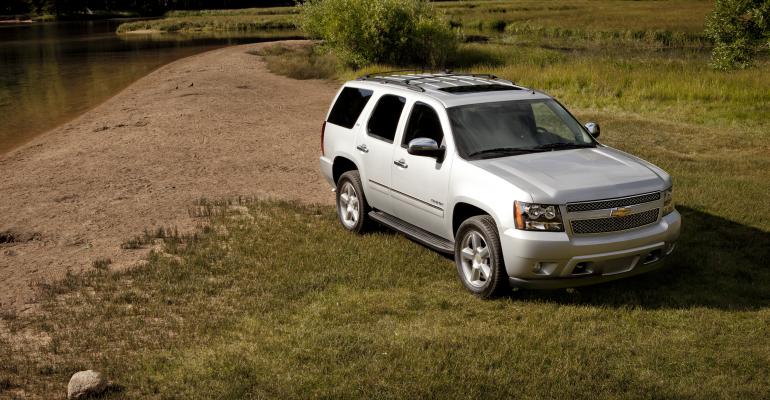If you’re thinking the days of the pricey, look-at-me big SUV are over, think again.
When the next-generation large SUVs from General Motors hit the market next year, the trucks will enter a segment shrunken from its heyday a decade ago but still highly profitable and targeting many customers unlikely to use them within an inch of their full potential.
The Chevrolet Tahoe and Suburban and the GMC Yukon and Yukon XL also will undoubtedly command higher sticker prices than the current models, which along with their competitors already boast average transaction prices nearly $20,000 greater than the industry average.
“You’ll see an uptick in ATPs,” John Schwegman, GM’s truck product and pricing chief, tells WardsAuto.
But that should be expected because the SUVs won’t just be new they’ll also be available with a raft of must-have technologies that have come out since their last redesign in 2007.
Loyal buyers hot to update their Tahoe or Yukon, which average 11 years old, with the industry’s latest navigation systems, connectivity options and entertainment systems will take segment ATPs into an entirely new realm.
And, holy smokes, is GM poised to cash in on their return.
According to WardsAuto data, the auto maker boasts 71.8% of the segment’s U.S. sales; Chevy alone controls 45.4%.
There are fewer competitors, too. Since the sector’s sales peak between 1995 and 2005, four models have vanished from the market. In fact, the segment could shrink even further if Toyota decides to stop production of the Sequoia or Nissan were to dry dock the Armada as some have speculated.
“We think we’re in a really good spot,” Schwegman says.
Although the large SUV segment shrunk a whopping 64.2% to 297,672 units in 2012 from 832,072 in 2005, plenty of Americans still want to put an exclamation point on their personal success with one of these light trucks.
According to Chevrolet Marketing Director Maria Rohrer, a surprisingly low 7% of Tahoe owners use their SUV to transport kids to school and a paltry 3% use the truck’s third row, meaning most of its 108.9 cubic ft. (3,084 L) of cargo space goes unused.
Nearly half of Tahoe owners, 45%, use their vehicle to commute to work and 52% never use an ounce of the truck’s maximum 8,500 lbs. (3,855 kg) of towing capacity.
About 1.3% takes advantage of the truck’s 4-wheel-drive and beefy suspension to go off road.
Rohrer says Tahoe customers are wealthy, well-educated, hard-working individuals who value their success and reward themselves with a big SUV, but choose a Chevrolet to avoid appearing overly conspicuous in their spending.
Fuel expenses occupy the bottom rungs of their purchase considerations, she says.
Chevy Suburban customers, meanwhile, tend to go the other way and pack their trucks with kids and cargo while trailering any assortment of personal recreation items.
So who departed the segment?
“Image-only, lease poseurs,” Rohrer says, alluding to those folks who 10 years ago took advantage of easy credit and cheap leases to play in a segment oftentimes above their household income.
Then in 2008, you’ll recall, pump prices shot over $4 per gallon and residual values on the trucks plummeted. The event contributed to the bankruptcy of GM’s former captive finance unit, GMAC, and the auto maker itself was stung with $2.0 billion loss for valuing future lease trade-ins artificially high.
Leases on the big SUVs all but disappeared, and those that remained were prohibitively expensive.
But leasing is back in a big way, says Scot Hall, executive vice president of Swaplease.com, which gets lessees out of cars they no longer want and puts the vehicles in the hands of people who are looking for a short-term lease.
The deals are becoming just as juicy as they were in 2005.
“The difference isn’t lower new-car prices, but stronger used-car prices,” says Hall, a Yukon Denali owner himself. “I would anticipate growth in leasing as the new GM models are introduced.”
GM appears to be in the cat-bird’s seat ready to feast on the segment’s comeback, however vigorous it might be and whoever might be buying.


